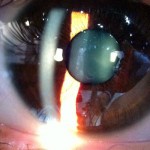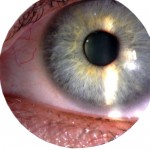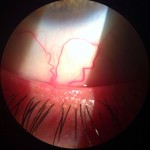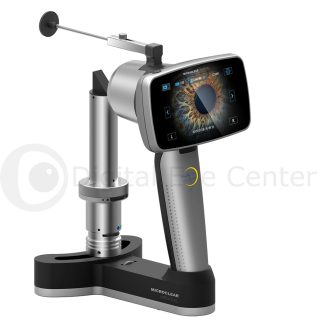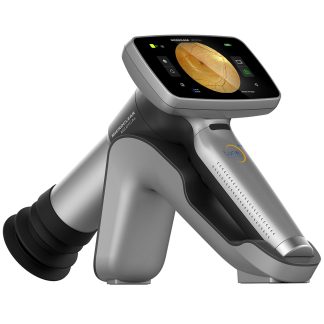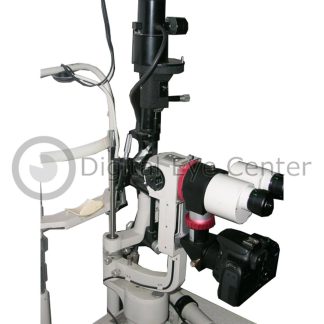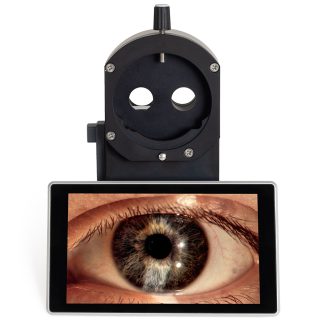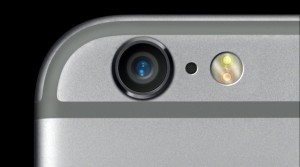
An intelligent way to take excellent slit lamp pictures is with an iPhone slit lamp adapter.
If you are a curious person, then by now, you have been trying to take pictures through your slit lamp with your iPhone, right?
I will detail the advantages of using an iPhone slit lamp adapter as your primary tool for digital photography, the different options you will find in the market, and how to use it to create fabulous pictures.
What did you try to do when you got your first iPhone? For me, it was the camera. The TV ads would not stop promoting the idea that this new iPhone would be the only camera we needed, so I had to test it—and I was not disappointed.
While Apple kept busy launching new versions of the iPhone, 3, 4, 4s, 5, 5s, etc., the camera has always been one of the main focuses of improvement: from the starting 3 megapixels on the first version to today’s 8 megapixels, bigger sensors, improved focus, and faster pictures.
Considerations for a high-quality picture
You will get an excellent picture when the main parameters of the camera are in perfect balance. These are:
Number of megapixels
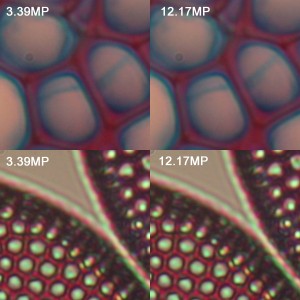
One of the most crucial camera parameters to consider when deciding what iPhone version to use for slit lamp photography is its number of megapixels, even though more megapixels don’t necessarily translate into better pictures.
There are other parameters to consider for better pictures, like the sensor size and the quality of the slit lamp. The iPhone slit lamp adapter has a 10X ocular so that it won’t affect the quality of the picture.
More megapixels means you can print the picture bigger, crop it, and maintain the same quality, but that’s about it. If you display them on a computer screen, 3 megapixels is enough.
When using an iPhone slit lamp adapter, you will get more than 5 megapixels if using iPhone 4 or 5. As you see in the picture to the right, you won’t see any noticeable difference between 3 and 12 megapixels when taking zoom photography.
For an in-depth explanation, please read this article: Do More Pixels Mean Better Photo Quality?
Sensor Size
The Sensor size will determine the amount of light and the range of colors in a picture; that’s why Apple has been improving the iPhone’s sensor and other camera features instead of just increasing the megapixels.
You’ll find an interesting discussion: Why did Apple use an 8-megapixel camera in the iPhone 6 and iPhone 6 Plus?
Slit Lamp quality
Another critical parameter to consider is the quality of the slit lamp. The lenses on the slit lamp are the most valuable component, and they will make a significant difference in the quality of the picture. So next time you think of getting a better camera, think instead about the possibility of getting a new slit lamp. When using the iPhone slit lamp adapter with different kinds of slit lamps, you will notice the big difference in output quality from an economy slit lamp to a brand-name one.
Here are pictures from a Haag Streit slit lamp. Notice the high definition:
Click Images to Zoom
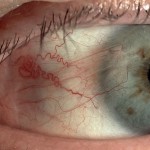 |
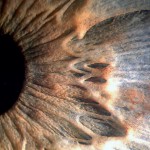 |
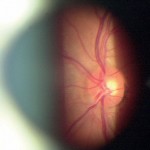 |
Why use an iPhone slit lamp adapter?
Although a slit lamp camera has advantages over a smartphone when taking anterior eye pictures, it is also known that the best camera is the one you have in your hand.
That’s how ophthalmology students began using their smartphones to take pictures cause they have them in their pockets. Sometimes you don’t have access to the slit lamp camera like when in a remote location; in this situation, you can use your smartphone for a quick picture of the eye. You may not get this method’s best photos, but they will be good enough.
An appropriate iPhone slit lamp adapter will allow you to focus better and cover a wider eye area.
Do I need background illumination?
An iPhone slit lamp adapter is perfect for anterior segment photography, but proper illumination can make a difference. Experimenting with the lighting and background illumination would best determine what works better. This photograph shows how different brightness affects the picture.
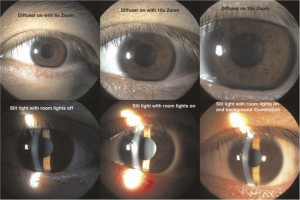
Components of an iPhone Slit Lamp adapter.
You will find a few slit lamp iPhone adapters on the market, all of which share this basic structure.
Holder for iPhone
There are two kinds of iPhone holders – Exact Fitting and Universal. Each has its advantages and disadvantages.
Exact Fitting Holder
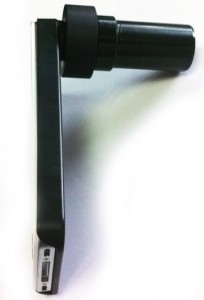
This type of case will fit exactly the shape of your phone, meaning you must first take off the current case to use your phone with the iPhone slit lamp adapter.
If you have a very tight or double case for better phone protection, taking it out every time you want to take a picture can be an issue.
In this case, I recommend using an iPhone exclusively for slit lamp photography. You can get a used iPhone 4s on eBay for $75 or an iPhone 5s for $240. Another option, if you are upgrading soon, is to leave the old phone for this purpose.
Because each iPhone model has a different shape, you must get an iPhone slit lamp adapter case designed for your particular model. i.e., if you bought the one for the iPhone 4 and upgraded to the iPhone 5, you will need to get a new adapter case for the new phone.
This is another reason to have a dedicated iPhone for the exclusive function of taking slit lamp pictures.
Universal Holder
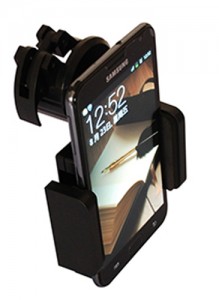
This adapter has one or two clamps that hold the sides and bottom of the smartphone. A sliding system moves to align the smartphone camera lens with the adapter hole.
One of the advantages of this adapter is that you can use it as an iPhone slit lamp adapter, and it will fit almost every smartphone on the market as well, so you don’t have to purchase a new case every time you upgrade phones. However, the adapter is not as solid as the “exact fit” case I mentioned.
Ocular attachment.
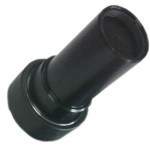
There are two ways to attach the iPhone slit lamp adapter case to the ocular:
- Slide-in adapter
- Over the eyepiece adapter
Let’s look more into these two options:
Slide In Ocular Adapter
The slide-in adapter is not just a metallic empty tube; it’s a 10x ocular itself. It will give the best picture quality.
It will require you first to slide out the ocular and slide in the iPhone slit lamp adapter attached to the case. So first, you should confirm this information:
- You can slide out the eyepiece. There are a few slit lamps where you must unscrew the eyepiece. In this case, you must use the “over-the-eyepiece adapter.”
- Measure the eyepiece’s diameter. The adapter’s ocular will replace the original ocular, so it must be the same size. Usually, the eyepieces are from 23 to 30 mm.
The iPhone slit lamp adapter’s ocular will fit the slit lamps with the smaller eyepieces. If you need a bigger diameter, you must either purchase an adapter with that diameter or get a different adapter sleeve.
This sleeve goes on top of the original eyepiece to fit on your slit lamp. You will find some companies that sell just the adapter that fits your slit lamp, while other companies will give you all the 3 or 4 sleeves, that way, you will be covered for most of the slit lamps in the market.
Over the Eyepiece Adapter
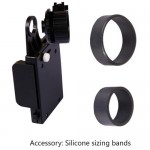
This iPhone slit lamp adapter will use a clamp that holds the phone to the ocular. If you have a slit lamp in which you can not slide out the eyepieces, this is your only option.
It works with all sizes of eyepieces. These adapters come with plastic covers you must put on the other until the clamp fits tightly. The smaller the diameter, the more covers you need. After taking the picture, you have to remove the adapter and the two or three covers. This is not as easy as just replacing the ocular, but it works.
Steps and Tips to Take the Best Pictures
Once you set up the iPhone slit lamp adapter, these are the steps to take your first picture.
- Turn off the iPhone’s Flash – No need for it. If you need more illumination, you can set up a background light on the slit lamp, but typically iPhone camera sensitivity is enough.
- You will focus on the iPhone touchscreen. What you see is what you get in the picture.
- Focus the slit lamp as you will typically do. Here are a couple of tips here:
- Zoom: Do all the zooming using the slit lamp magnification, not through the iPhone’s zoom. You will get better results, as the iPhone will do a digital zoom instead of a manual one.
- Focus: You will not see the complete eye focus unless you are in the lowest slit lamp magnification. You focus on the iPhone camera by touching the screen in the spot you want to be in focus. This action will both focus and adapt the illumination of the whole picture to that spot.
- If you want to focus on one spot while changing the illumination, you do this: Instead of just tapping once on the spot, tap and hold for 2 seconds. You will see a yellow square and an “AF locked” label; now, you can move your finger up and down for more or less light.
These are some sample shots from an iPhone 4:
Thanks to the iPhone’s HDR (high dynamic range) setting, you can get pictures with a greater dynamic range of luminosity than with a standard camera. Even though some of the newer cameras come with an HDR function, the HDR on the phone will take three pictures at different light levels instead of one. Then, it will combine them to find the best light from all areas of the picture and create one last improved image.
Thanks to all these technological advances, an iPhone slit lamp adapter is becoming indispensable in every optical practice. Now you could tell me why.


